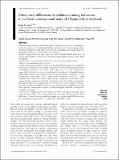Files in this item
Urban-rural differences in adolescent eating behaviour : a multilevel cross-sectional study of 15-year-olds in Scotland
Item metadata
| dc.contributor.author | Levin, Kate Ann | |
| dc.date.accessioned | 2014-09-04T11:01:01Z | |
| dc.date.available | 2014-09-04T11:01:01Z | |
| dc.date.issued | 2014-08 | |
| dc.identifier | 67973552 | |
| dc.identifier | 930ce5e2-714e-454a-b6cc-dce3c8cc04c1 | |
| dc.identifier | 000340164600013 | |
| dc.identifier | 84903733861 | |
| dc.identifier | 23962450 | |
| dc.identifier | 000340164600013 | |
| dc.identifier.citation | Levin , K A 2014 , ' Urban-rural differences in adolescent eating behaviour : a multilevel cross-sectional study of 15-year-olds in Scotland ' , Public Heath Nutrition , vol. 17 , no. 8 , pp. 1776-1785 . https://doi.org/10.1017/S1368980013002127 | en |
| dc.identifier.issn | 1368-9800 | |
| dc.identifier.uri | https://hdl.handle.net/10023/5343 | |
| dc.description | This work was supported by NHS Health Scotland and the Ludwig Boltzmann Institute. However, NHS Health Scotland and the Ludwig Boltzmann Institute had no role in the design, analysis or writing of this article. | en |
| dc.description.abstract | Objective: Improving the diet of the Scottish population has been a government focus in recent years. Population health is known to vary between geographies; therefore alongside trends and socio-economic inequalities in eating behaviour, geographic differences should also be monitored. Design: Eating behaviour data from the 2010 Scotland Health Behaviour in School-aged Children survey were modelled using multilevel linear and logistic modelling. Setting: Data were collected in schools across urban and rural Scotland. Subjects: Schoolchildren aged 15 years. Results: Adolescents living in remote rural Scotland had the highest consumption frequency of vegetables (on average consumed on 6·68 d/week) and the lowest consumption frequency of sweets and crisps (on 4·27 and 3·02 d/week, respectively). However, it was not in the major four cities of Scotland (Glasgow, Edinburgh, Dundee and Aberdeen) but in the geography described by the classification ‘other urban’ areas (large towns of between 10 000 and 125 000 residents) that adolescents had the poorest diet. Deprivation and rurality were independently associated with food consumption for all but fruit consumption. Sharing a family meal, dieting behaviour, food poverty and breakfast consumption did not differ by rurality. Variance at the school level was significant for fruit and vegetable consumption frequencies and for irregular breakfast consumption, regardless of rurality. Conclusions: Young people from rural areas have a healthier diet than those living in urban areas. The eating behaviours examined did not explain these differences. Future research should investigate why urban–rural differences exist for consumption frequencies of ‘healthy’ and ‘unhealthy’ foods. | |
| dc.format.extent | 10 | |
| dc.format.extent | 128950 | |
| dc.language.iso | eng | |
| dc.relation.ispartof | Public Heath Nutrition | en |
| dc.subject | Urban–rural | en |
| dc.subject | Eating behaviour | en |
| dc.subject | Adolescent | en |
| dc.subject | Scotland | en |
| dc.subject | Food-frequency questionnaire | en |
| dc.subject | Aged children HBSC | en |
| dc.subject | Health behavior | en |
| dc.subject | Inequalities | en |
| dc.subject | Deprivation | en |
| dc.subject | Accessibility | en |
| dc.subject | Determinants | en |
| dc.subject | Reliability | en |
| dc.subject | Environment | en |
| dc.subject | Vegetables | en |
| dc.subject | TX Home economics | en |
| dc.subject | GF Human ecology. Anthropogeography | en |
| dc.subject | RA0421 Public health. Hygiene. Preventive Medicine | en |
| dc.subject | HA Statistics | en |
| dc.subject | SDG 3 - Good Health and Well-being | en |
| dc.subject.lcc | TX | en |
| dc.subject.lcc | GF | en |
| dc.subject.lcc | RA0421 | en |
| dc.subject.lcc | HA | en |
| dc.title | Urban-rural differences in adolescent eating behaviour : a multilevel cross-sectional study of 15-year-olds in Scotland | en |
| dc.type | Journal article | en |
| dc.contributor.institution | University of St Andrews. School of Medicine | en |
| dc.contributor.institution | University of St Andrews. Child and Adolescent Health Research Unit | en |
| dc.identifier.doi | https://doi.org/10.1017/S1368980013002127 | |
| dc.description.status | Peer reviewed | en |
This item appears in the following Collection(s)
Items in the St Andrews Research Repository are protected by copyright, with all rights reserved, unless otherwise indicated.

